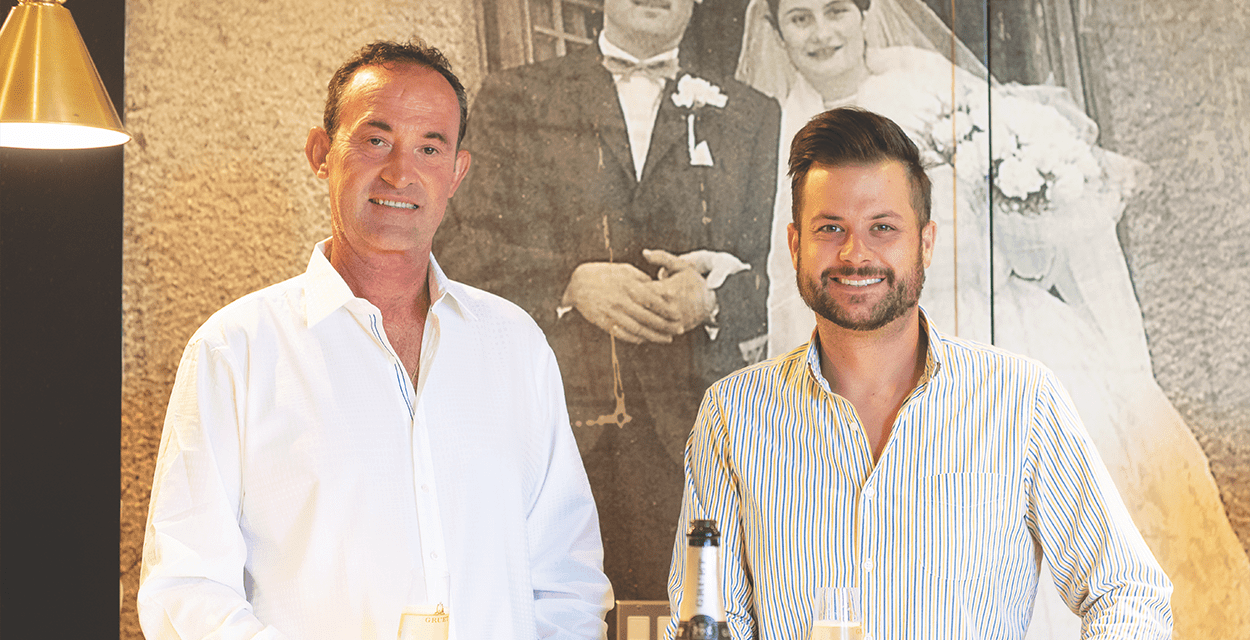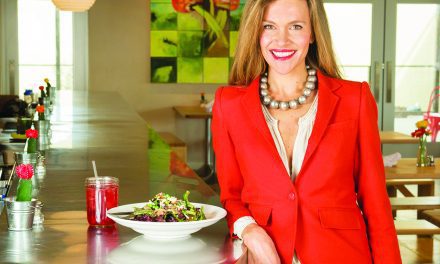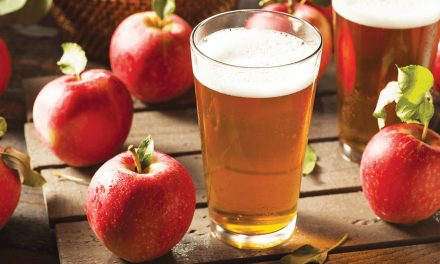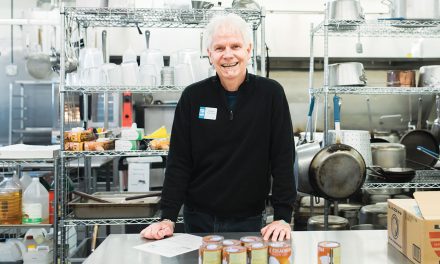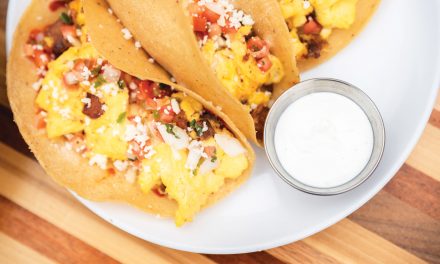an interview with Laurent Gruet, Winemaker
Photo by Stephanie Cameron
An edible Local Hero is an exceptional individual or organization working to create innovative, vibrant, and resilient local food systems in New Mexico. Last fall, edible readers nominated and voted for their favorite food artisans, growers, and advocates in nearly two dozen categories—including six new awards. Each issue of edible will contain interviews with several of the winners, spotlighting the important and exciting work they do. It is imperative to the local food movement that we come together as a community to support each other, our local economy, and our environment. Please join us in thanking these local heroes for being at the forefront of that effort.

Laurent Gruet and his nephew Sofian Himeur.
In his youth, Laurent followed his father Gilbert Gruet into winemaking at Gruet et Fils Winery in Bethon, France. He was mentored primarily by his father, with supplemental studies at Lycée Viticole de la Champagne in Avize, France. Following his father to the United States in pursuit of expansion and affordable vineyards, Laurent and his sister Nathalie moved to New Mexico in 1984. The two (of four) siblings endeavored on the American enterprise, Gruet Winery. The first official wine release from the Albuquerque-based winery was in 1989.
What is your backstory, and what was the moment that brought you to your current work?
For me, winemaking is practically genetic. My earliest memories of wine were of being alongside my father in Bethon, France. As a boy, you’d find me cleaning tanks, pumping wines, and helping on the bottling line. At age seven, I was allowed to taste wine.
I worked harvests like everyone else and made my first champagne in 1981, a Blanc de Blancs at Gruet et Fils. Between learning from my father, taking some coursework, and learning from our friend Clement Novack at the winery, I feel lucky to have received a practical education, learning by doing.
A lot of French vintners were staking their claim in America through the 1970s and early 1980s. My father was intrigued. He considered land in other states, but ultimately saw potential in New Mexico. My sister Nathalie and I stayed in 1984, and my father basically helped us set things up, but the rest was up to my sister and me. He and my mom went right back to France. There was a steep learning curve. While New Mexico soil does work for vinifera grapes, the weather was much more extreme than in France; here we have higher elevation, hotter summers, some winter freezes, and at times, whipping winds. We have learned what works. We persevered, and with some massive orders from New York and California in 1989, we were on the map and never looked back.
In 2011, Wine Spectator named our Gruet NV Blanc de Noirs a Top 100 wine of the world, nearly unprecedented for a sparkling wine under twenty dollars. We continue to delight wine drinkers all over the world. I love seeing the surprise on people’s faces when they learn this wine is made in New Mexico, not Champagne.
How has winemaking and wine in New Mexico changed since you started Gruet in 1984?
There is more growth in the number of wineries and the wine, though mostly still, has taken its taste profiles more toward dry than it did in the late 1980s and 1990s. Through advocacy organizations, such as New Mexico Wine, there is also unity and a commitment to excellence. The organization hosts experts and people to run lab testing or peer-to-peer review, if needed. Last year, many wineries with New Mexico Wine held a media tour for national wine writers, who were surprised to see how vibrant the state’s industry has become.
How is your approach different than other winemakers in New Mexico?
Definitely being a Champagne method winery in this state makes Gruet a standout. Making bubbles is a very different process than making still wine (and we make some still wine, too!), from the processing stages to the bottling line. Much of our winemaking equipment comes from France, and we still send samples of wine back to France for highly detailed lab analyses (we have used Dominique Leboeuf, a long-time friend of my father Gilbert Gruet, who does the lab analysis for top Champagne houses).
Another big one: Harvest for us takes place at a totally different time here, much earlier than for still wineries’ grapes. Our growing season is from mid-April to the end of July, and during the day it’s one hundred degrees on average, but then we’re on about 4300 feet of elevation, so it gets down to thirty or forty degrees at night. This difference between daytime and nighttime temperatures is known as a diurnal shift, and it’s crucial for preserving the acidity in grapes, and results in a bright and lively wine. Big diurnal shifts slow the ripening process, so that grapes don’t have overshot sugar levels. For sparkling wine and Champagne, you don’t want high sugars in the grapes.
Do you have a favorite Gruet wine and what meal do you like to pair it with?
My favorite sparkling wine to make is the Gruet Grande Reserve, a Blanc de Blancs that is as true to Old World champagne as possible in America: rich, complex, and long-finishing. It is barrel-fermented like the old style, and some of the best Champagne houses still use this method today. The style reminds me of my childhood. On the palate, it has great refreshing zip and pairs beautifully with shellfish (grilled oysters, a shrimp salad, even steamed crab). The wine’s light citrus notes marry well with that “ocean breeze” quality of shellfish.
Are there any new techniques or tools you are experimenting with, or would like to in the future?
More recently, we have been playing with and making more zero dosage wines under a category called Sauvage. One is one hundred percent chardonnay and the other is a rosé. Sauvage is a mixture of wine and sugar added twice during the Champagne method process: first, to provide food for yeasts and induce fermentation in the bottle to make bubbles; then to top off the wine at a bottling, because it loses some liquid when it’s disgorged. Sugar in dosage doesn’t really make the wine sweet (it’s very difficult to actually taste the sugar when you are drinking the wine), but a zero dosage wine with no sugar makes for a beautifully clean and pure wine, puts the fruit forward, and offers a racy acidity.
Is there anything else you would like edible readers to know?
Yes! Two things:
Gruet has a thriving partnership with the Pueblo of Santa Ana at Tamaya Vineyard to grow wine grapes, in addition to our own vineyard and other area sources. This started in 2014 as a means of economic development for the pueblo, and we grow chardonnay, pinot noir, and, eventually, pinot meunier. We are beginning to get a significant harvest from this thirty-acre vineyard and plan to expand. It’s a win-win that provides jobs and economic diversity for the pueblo, while supplying our winery with much-needed grapes.
My right hand at the winery is my nephew and assistant winemaker Sofian Himeur (he is my sister Nathalie’s son). I draw great satisfaction in passing along winemaking knowledge from my late father, his grandfather, to him. Like me, Sofian basically grew up in the winery (only for him, it was this one in Albuquerque!) and for a long time he worked on the sales and marketing side. We were all very close to the late Gilbert, our patriarch, and the family legacy of winemaking has secured a third generation.
8400 Pan American NE, Albuquerque, 505-821-0055,
gruetwinery.com
Edible celebrates New Mexico's food culture, season by season. We believe that knowing where our food comes from is a powerful thing. With our high-quality, aesthetically pleasing and informative publication, we inspire readers to support and celebrate the growers, producers, chefs, beverage and food artisans, and other food professionals in our community.

